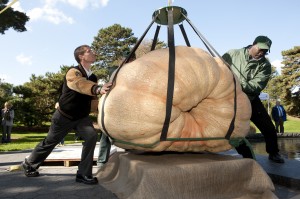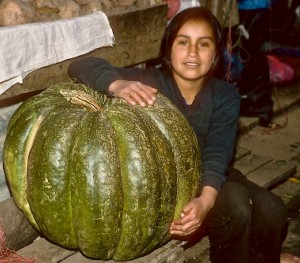Origin of the Giant Pumpkin
Posted in Programs and Events, Science on October 26 2010, by Thomas Andres
| Thomas C. Andres is an Honorary Research Associate at the Garden. |

I am especially excited that three record-breaking pumpkins are on display this month at The New York Botanical Garden. The heaviest one is not only the heaviest fruit ever grown, but also the heaviest fruit in the plant kingdom! The scientific name of the species, Cucurbita maxima, says it all. How did this all come about?
First, I should explain my relationship with these plants. I work here at the Botanical Garden with Michael Nee on the taxonomy of the genus Cucurbita. This group of a little over a dozen species includes the squashes, pumpkins, and certain kinds of gourds. They all originally grew wild in the tropical and subtropical Americas. Five of the species were domesticated and represent some of our oldest New World crop plants. This means that Italy not only didn’t have tomatoes before Columbus, but no zucchini!
Wild Cucurbita fruit are like a baseball in size, shape, and even almost in hardness. This is quite large for a wild fruit, although nothing to write to the Guinness Book of World Records about. So how could a fruit that is so hard and so big travel around enough to form new populations? Wild Curcurbita do often grow in flood plains, and float during floods, but they would then only float in one direction: downstream.
One now widely held theory is that wild Curcurbita are anachronisms left over from the Pleistocene. That is, they once had dispersal agents who co-evolved with them, but then went extinct. Who could disperse a baseball besides the Yankees? Answer: Very large vegetarians like giant ground sloths, toxodons, gomphotheres, and mastodons! These megafauna went extinct during the Late Pleistocene, around 10,000 years ago, soon after humans crossed the land bridge from Asia into the Americas. These newly arrived migrants were not good vegetarians, but as their wild game disappeared, they abandoned their hunter-gatherer lifestyle and became more sedentary. They gathered in larger groups and relied upon a new invention to feed them: agriculture.
How plants become domesticated is a fascinating subject of vast treatises. But in short (and in keeping with the story at hand), the wild Curcubita were shaped by these early farmers. The gourd-like squash were selected by the early pumpkin-growers for qualities like palatability and size, along with secondary traits like softer rinds of various shapes and colors.

By the time of the European Conquest, squash of up to 200 lbs (90 kg) were common in South America. It may sound like a long way from 200 lbs to the 1,810.5 lbs (821.23 kg) of today’s World Record-holder, but it has taken a remarkably short amount of time. Many factors had to come together.
First, the plants had to be moved out of the tropics. Although the growing season is much longer in the tropics, day length is short and the large fruits are subjected to many pests and diseases over an extended growing period. At our latitude the fruits can grow quickly during the long summer days. This first step occurred in the 1700s when C. maxima fruits from South America reached New England and Europe.
Next, selective breeding specifically aimed at growing larger fruit took place. This began in earnest a little over a hundred years ago when more diversity became available and different cultivars could be crossed. These large fruits became curiosities, most notably in 1893 where a 365-pounder from Ontario, grown by William Warnock was exhibited at the Chicago World’s Fair. In 1900, Warnock took the prize at the World’s Fair in Paris with the first 400 lb pumpkin.
For the next 70 years, little changed in this maximum weight. Finally, in the 1970s and 80s, records started being smashed … I mean squashed, when Howard Dill of Nova Scotia bred the ‘Atlantic Giant’ pumpkin, which is the basis for all giant pumpkins today.
The third critical factor in achieving larger pumpkins was an improvement in cultural practices. It has been known since at least William Warnock’s time that to achieve maximum size, only one fruit per vine should be allowed to ripen, but many other improvements are still being discovered and tweaked concerning how to treat the soil, leaves, and fruit throughout the growing season. Best practices in cultivation are a constant source of discussion and debate among passionate giant pumpkin growers.
The final ingredient in growing a record-breaking pumpkin is luck. Gravity has taken its toll on many of these giants. They can literally be crushed by their own weight like a beached whale. Great care must be taken in preventing the sun from overheating one side of the fruit and causing an explosion.
In 1996, the milestone of the first over a 1,000-pound pumpkin was reached; in fact there were two that year. Since then there have been hundreds that have exceeded this weight. Is there a limit? Obviously, yes, but I’ve been wrong before about what that is, so I won’t wager a guess now.
Ask any prize-winning pumpkin grower (and I had the opportunity to talk to several) and they’ll tell you that a one ton (2,000 lbs) pumpkin will not only happen soon, but that they are actively working on that goal. So when might that be? By graphing the record-breaking pumpkins each year and extrapolating the correlation to 2,000 pounds, it can be expected that this unbelievable achievement will happen around the year 2014.
It seems that a weight that year of 2,014 lbs would be most appropriate. Play ball!
I will blog more about these remarkable behemoths at the Garden after they are cut open the end of this month to extract the seeds.


Great story on plants we don’t think about often. Thanks!